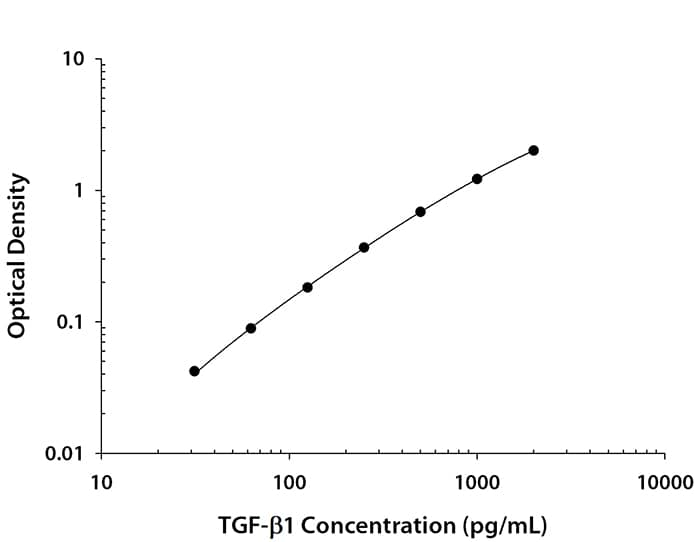Human/Mouse/Rat/Porcine/Canine TGF-beta 1 ELISA - Quantikine Best Seller
R&D Systems, part of Bio-Techne | Catalog # DB100C

Key Product Details
Assay Length
Sample Type & Volume Required Per Well
Sensitivity
Assay Range
Product Summary for Human/Mouse/Rat/Porcine/Canine TGF-beta 1 Quantikine ELISA
Product Specifications
Measurement
Detection Method
Conjugate
Reactivity
Specificity
Cross-reactivity
Interference
Sample Values
| Human Samples | Mean (pg/mL) | Range (pg/mL) | Standard Devitation (pg/mL) |
| Serum (n=31) | 51,640 | 32,091-95,147 | 11,901 |
| platelet-poor EDTA plasma (n=31) | 2377 | 1414-4641 | 729 |
| Platelet-poor heparin plasma (n=31) | 2383 | 1445-3653 | 561 |
| Urine* (n=10) | 65.9 | ND-108 | --- |
| Mouse Samples | Mean (pg/mL) | Range (pg/mL) | Standard Deviation (pg/mL) |
| Serum (n=10) | 97,352 | 78,751-114,130 | 12,623 |
| Platelet-poor EDTA plasma (n=10) | 41,763 | 16,577-68,505 | 16,887 |
| Platelet-poor heparin plasma (n=10) | 41,101 | 18,195-66,700 | 17,419 |
| Rat Samples | Mean (pg/mL) | Range (pg/mL) | Standard Deviation (pg/mL) |
| Serum (n=10) | 68,108 | 43,721-89,138 | 14,343 |
| Platelet-poor EDTA plasma (n=5) | 5833 | 4912-7820 | 1141 |
| Platelet-poor heparin plasma (n=5) | 13,971 | 5274-26,114 | 8392 |
| Porcine Samples | Mean (pg/mL) | Range (pg/mL) | Standard Deviation (pg/mL) |
| Serum (n=5) | 17,597 | 13,481-23,914 | 4146 |
| Platelet-poor EDTA plasma (n=5) | 1955 | 1530-2810 | 518 |
| Platelet-poor heparin plasma (n=5) | 1567 | 1111-2475 | 551 |
| Canine Samples | Mean (pg/mL) | Range (pg/mL) | Standard Deviation (pg/mL) |
| Serum (n=10) | 33,455 | 2193-79,590 | 19,795 |
| Platelet-poor EDTA plasma** (n=5) | 2195 | ND-2515 | — |
| Platelet-poor heparin plasma*** (n=5) | 3763 | ND-4278 | — |
Cell Culture Supernates:
Precision
Intra-Assay Precision (Precision within an assay) Three samples of known concentration were tested twenty times on one plate to assess intra-assay precision.
Inter-Assay Precision (Precision between assays) Three samples of known concentration were tested in separate assays to assess inter-assay precision. Assays were performed by at least three technicians using two lots of components.
Cell Culture Supernates, Platelet-poor EDTA Plasma, Platelet-poor Plasma, Serum, Urine
| Intra-Assay Precision | Inter-Assay Precision | |||||||||||
|---|---|---|---|---|---|---|---|---|---|---|---|---|
| Sample | 1 | 2 | 3 | 4 | 5 | 6 | 1 | 2 | 3 | 4 | 5 | 6 |
| n | 20 | 20 | 20 | 20 | 20 | 20 | 20 | 20 | 20 | 20 | 20 | 20 |
| Mean (pg/mL) | 317 | 683 | 1271 | 309 | 708 | 1072 | 312 | 657 | 1184 | 303 | 622 | 1092 |
| Standard Deviation | 11.3 | 42.2 | 31.1 | 15.3 | 40.0 | 44.3 | 26.1 | 46.6 | 92.3 | 21.2 | 47.2 | 70.0 |
| CV% | 3.6 | 6.2 | 2.4 | 5.0 | 5.6 | 4.1 | 8.4 | 7.1 | 7.8 | 7.0 | 7.6 | 6.4 |
Recovery for Human/Mouse/Rat/Porcine/Canine TGF-beta 1 Quantikine ELISA
The recovery of TGF-beta 1 spiked to levels throughout the range of the assay in activated samples was evaluated.
| Sample Type | Average % Recovery | Range % |
|---|---|---|
| Media + FBS (n=4) | 103 | 80-125 |
| Platelet-poor EDTA Plasma (n=4) | 90 | 83-98 |
| Platelet-poor Plasma (n=4) | 90 | 77-107 |
| Serum-free Cell Culture Media (n=4) | 87 | 82-95 |
| Urine (n=4) | 114 | 105-123 |
Linearity
To assess linearity of the assay, the activated samples containing and/or spiked with high concentrations of TGF-beta 1, were diluted with calibrator diluent to produce samples with values within the dynamic range of the assay.

Scientific Data Images for Human/Mouse/Rat/Porcine/Canine TGF-beta 1 Quantikine ELISA
Human TGF-beta 1 ELISA Cell culture supernate/Urine Standard Curve
Human TGF-beta 1 ELISA Serum/Platelet-poor Plasma Standard Curve
Preparation and Storage
Shipping
Stability & Storage
Background: TGF-beta 1
Transforming Growth Factor Beta 1, 2, and 3 (TGF-beta 1, TGF-beta 2, and TGF-beta 3) are highly pleiotropic cytokines that virtually all cell types secrete. TGF-beta molecules are proposed to act as cellular switches that regulate processes such as immune function, proliferation, and epithelial-mesenchymal transition. Targeted deletions of these genes in mice show that each TGF-beta isoform has some non-redundant functions: TGF-beta 1 is involved in hematopoiesis and endothelial differentiation; TGF-beta 2 affects development of cardiac, lung, craniofacial, limb, eye, ear, and urogenital systems; and TGF-beta 3 influences palatogenesis and pulmonary development. The full range of in vitro biological activities of TGF-beta 5 has not yet been explored. However, TGF-beta 1, TGF-beta 2, TGF-beta 3, and TGF-beta 5 have been found to be largely interchangeable in an inhibitory bioassay, and it is anticipated that TGF-beta 5 will show a spectrum of activities similar to the other TGF-beta family members. To date, the production of TGF-beta 5 has only been demonstrated in Xenopus.
TGF-beta ligands are initially synthesized as precursor proteins that undergo proteolytic cleavage. The mature segments form active ligand dimers via a disulfide-rich core consisting of the characteristic 'cysteine knot'. TGF-beta signaling begins with binding to a complex of the accessory receptor betaglycan (also known as TGF-beta RIII) and a type II serine/threonine kinase receptor termed TGF-beta RII. This receptor then phosphorylates and activates a type I serine/threonine kinase receptor, either ALK-1 or TGF-beta RI (also called ALK-5). The activated type I receptor phosphorylates and activates Smad proteins that regulate transcription. Use of other signaling pathways that are Smad-independent allows for distinct actions observed in response to TGF-beta in different contexts.
Long Name
Alternate Names
Gene Symbol
Additional TGF-beta 1 Products
Product Documents for Human/Mouse/Rat/Porcine/Canine TGF-beta 1 Quantikine ELISA
Product Specific Notices for Human/Mouse/Rat/Porcine/Canine TGF-beta 1 Quantikine ELISA
For research use only

